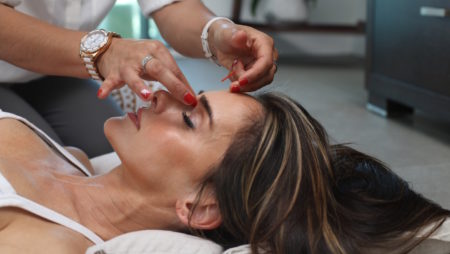One topic of interest lately has been red vs blue light and how the different spectrums of light affect our biology and skin.
I believe that light, oxygen, and energy therapy will be the next medical breakthrough for treating disease, aging, energy, hormonal imbalance, skin issues, or any ailment you can think of as we learn more about what has the greatest impact on our genes, cells, and organs.
Turns out, light has a HUGE effect on all of it and we can use it in powerful (or destructive) ways every single day.
Problems with Artificial Light
Exposure to artificial light may be drastically affecting our biology. For most of history, people rose and slept with the sun. Their circadian rhythm was controlled by the light of the sun and moon.
Now, we experience light at all times of day and night. Electronics and artificial lighting emit blue light, which only occurs in nature during the brightest part of the day. So when we encounter light that would only occur in nature during the bright afternoon hours at 11:00 PM, many problems begin to occur.
Artificial blue light after dark messes up the cortisol/melatonin balance, which then throws other hormones and systems off.
How Light Effects Your Biology: Red vs Blue Light
Blue Light
The body relies on light to signal times it should be awake vs times it should be sleep. Blue light signals the brain to turn off melatonin production.
Blue light (preferably from direct sunlight) is important to be exposed to in the morning and throughout the day because it:
- Signals the brain for proper melatonin production
- Promotes mood and alertness
- Signaling the body to maintain healthy weight and adrenal function
Blue light is great for mental and physical health, but only during the DAY. Being exposed to blue light after the sun goes down is where the problems begin.
We are supposed to have high cortisol in the mornings to make us alert and awake and low cortisol at night to make us tired. Many people today have the opposite going on – they have low cortisol in the morning which makes it hard to wake up, and high cortisol at night which makes it hard to sleep. Being up late at night with all of our devices is a huge culprit of this problem.
Because blue light suppresses melatonin, we are throwing off the process of what our entire hormonal system is supposed to go through each night. Melatonin is important for other hormones to be produced correctly as well as proper sleep.
Red Light
Red lights (such as campfires) do not suppress melatonin but rather promote it.
Specific wavelengths of red light create a biochemical effect in our cells that serves to increase mitochondrial function. This improves ATP production in the body.
ATP is the source of energy for every cell in the body. Without it, we don’t function at all. Without enough of it, we don’t function well.
Red light has been shown as a therapeutic treatment for skin issues, inflammation, reducing wrinkles, stretch marks, balancing hormones, increasing collagen production and cellular rejuvenation.
Red light can be extremely healing, but many of us are not exposed to red light anymore as blue light from our computers, phones, and TVs has taken over our evenings.
Related article: how to get rid of anxiety
Red vs Blue Light on Skin
As an Esthetician, I have seen light therapy transform skin.
Blue light has been shown to penetrate the skin’s hair follicles and pores which harbor bacteria and can cause inflammation, and therefore acne. Bacteria are very sensitive to the blue light spectrum—it shuts down their metabolism and kills them.
The primary function of red light therapy is to help accelerate wound healing, stimulate collagen production, and aid in fading sunspots and hyperpigmentation.
Just think: acne – blue light ….. collagen production – red light.
Tips to Use Light to Improve Health, Energy, & Mood
As far as red vs blue light goes, you should be in the light during the day and have little light exposure (especially artificial light) at night so your body’s internal regulation system stays in balance.
Get Outside in the Sunlight First Thing in the Morning
Getting out in the sun first thing in the morning as this stimulates cortisol (in a good way) for a better mood and energy as well as better sleep at night.
Use Low Lighting After the Sun Goes Down
After the sun goes down we only use red/orange lighting in the house. This looks like having orange light bulbs in the kitchen and then salt lamps in other rooms of the house.
Wear Blue Light Blocking Glasses & Download Flux
My husband and I also wear blue light blocking glasses when we are on our computers after the sun goes down.
You can also download Flux for your devices which takes out some of the blue light your computer puts out.
Use Red and Near Infrared Light Therapy in Your Own Home!
After reading many JOOVV light reviews, we decided to get one and we are loving it! Every night we sit in front of this amazing red and near-infrared light device (the JOOV). It has been incredible for my daughter’s skin, my mood and skin tone, and healing my husband’s foot after he went cliff diving and tore it open (facepalm).
You can check out the JOOV Light Device we have here.
You can read our JOOVV light reviews here.
I have noticed that our family (the baby especially!) goes to sleep easily and wakes up happy when we follow the rhythms of natural light.

Red vs Blue Light



One Comment
Good article! But to be honest I dont know that much about light therapy but I did know the color of light affects our mood and what not but my curiosity in to random things brought me here. Lol that didnt sound quite right. What I mean is that I randomly thought why some city police vehicles use only blue lights and others havent changed the typical red and blue ones.What I did learn is that blue light promotes mood/alertness (among other thing) but does the amount of exposure to it affect the mood/alertness? I wonder if they use blue lights because people are more alert with the blue rather than red ?